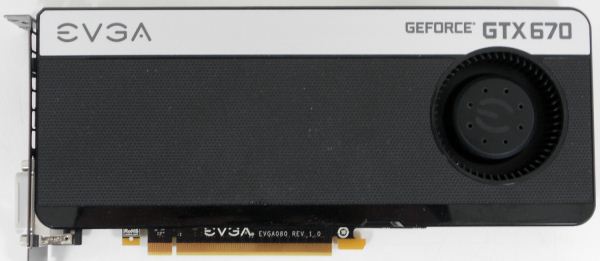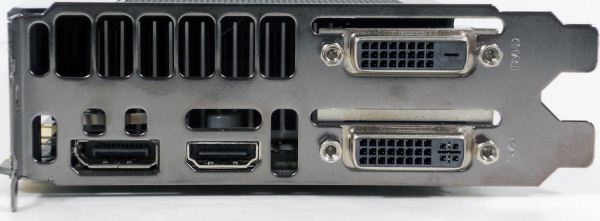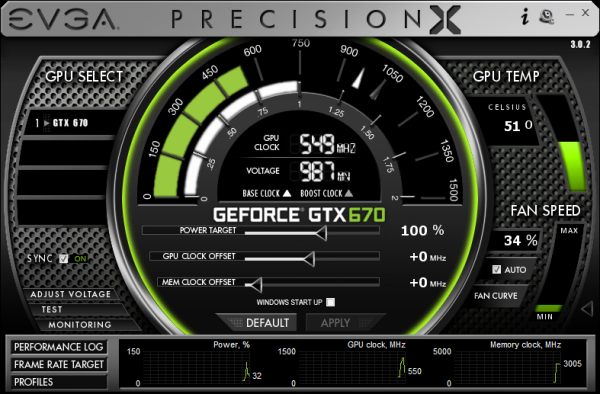NVIDIA GeForce GTX 670 Review Feat. EVGA: Bringing GK104 Down To $400
by Ryan Smith on May 10, 2012 9:00 AM ESTMeet The EVGA GeForce GTX 670 Superclocked
Our second card of the day is EVGA’s GeForce GTX 670 Superclocked, which in EVGA’s hierarchy is their first tier of factory overclocked cards. EVGA is binning GTX 670s and in turn promoting some of them to this tier, which means the GTX 670 Superclocked are equipped with generally better performing chips than the average reference card.
| GeForce GTX 670 Partner Card Specification Comparison | ||||
| EVGA GeForce GTX 670 Superclocked | GeForce GTX 670 (Ref) | |||
| CUDA Cores | 1344 | 1344 | ||
| Texture Units | 112 | 112 | ||
| ROPs | 32 | 32 | ||
| Base Clock | 967MHz | 915MHz | ||
| Boost Clock | 1046MHz | 980MHz | ||
| Memory Clock | 6210MHz | 6008MHz | ||
| Memory Bus Width | 256-bit | 256-bit | ||
| Frame Buffer | 2GB | 2GB | ||
| TDP | 170W | 170W | ||
| Manufacturing Process | TSMC 28nm | TSMC 28nm | ||
| Width | Double Slot | Double Slot | ||
| Length | 9.5" | 9.5" | ||
| Warranty | 3 Years | N/A | ||
| Price Point | $419 | $399 | ||
For the GTX 670 SC, EVGA has given both the core clock and memory clock a moderate boost. The core clock has been increased by 52MHz (6%) to 967MHz base and 66MHz (7%) boost to 1046MHz. Meanwhile the memory clock has been increased by 202MHz (3%) to 6210MHz.
Other than the clockspeed changes, the GTX 670 SC is an almost-reference card utilizing a reference PCB with a slightly modified cooler. EVGA is fabricating their own shroud, but they’ve copied NVIDIA’s reference shroud down to almost the last detail. The only functional difference is that the diameter of the fan intake is about 5mm less, otherwise the only difference is that EVGA has detailed it differently than NVIDIA and used some rounded corners in place of square corners.
The only other change you’ll notice is that EVGA is using their own high flow bracket in place of NVIDIA’s bracket. The high flow bracket cuts away as much metal as possible, maximizing the area of the vents. Though based on our power and temperature readings, this doesn’t seem to have notably impacted the GTX 670 SC.
While we’re on the matter of customized cards and factory overclocks, it’s worth reiterating NVIDIA’s position on factory overclocked cards. Reference and semi-custom cards (that is, cards using the reference PCB) must adhere to NVIDIA’s power target limits. For GTX 670 this is a 141W power target, with a maximum power target of 122% (170W). Fully custom cards with better power delivery circuitry can go higher, but not semi-custom cards. As a result the flexibility in building semi-custom cards comes down to binning. EVGA can bin better chips and use them in cards such as the Superclocked – such as our sample which can go 17 boost bins over the base clock versus 13 bins for our reference GTX 670 – but at the end of the day for stock performance they’re at the mercy of what can be accomplished within 141W/170W.
In any case, as the card is otherwise a reference GTX 670 EVGA is relying on the combination of their factory overclock, their toolset, and their strong reputation for support to carry the card. EVGA has priced the card at $419, $20 over the GTX 670 MSRP, in-line with other factory overclocked cards.
On the subject of pricing and warranties, since this is the first EVGA card we’ve reviewed since April 1st, this is a good time to go over the recent warranty changes EVGA has made.
Starting April 1st, EVGA has implemented what they’re calling their new Global Warranty Policy. Starting July 1st, 2011 (the policy is being backdated), all new EVGA cards ship with at least a 3 year warranty. And for the GTX 600 series specifically, so far EVGA has only offered models with a 3 year warranty in North America, which simplifies their product lineup.
To complement the 3 year warranty and replace the lack of longer term warranties, EVGA is now directly selling 2 and 7 year warranty extensions, for a total of 5 and 10 years respectively. So instead of buying a card with a 3 year warranty or a longer warranty, you’ll simply buy the 3 year card and then buy a warranty extension to go with it. However the extended warranty requires that the card be registered and the warranty purchased within 30 days.
The second change is that the base 3 year warranty no longer requires product registration. EVGA has other ways to entice buyers into registering, but they’ll now honor all applicable cards for 3 years regardless of the registration status. At the same time the base 3 year warranty is now a per-product warranty (e.g. a transferable warranty) rather than per-user warranty, so the base warranty will transfer to 2nd hand buyers. The extended warranties however will not.
The third change is how EVGA is actually going to handle the warranty process. First and foremost, EVGA is now allowing cards to be sent to the nearest EVGA RMA office rather than the office for the region the card was purchased from. For example a buyer moving from Europe to North America can send the card to EVGA’s North American offices rather than sending it overseas.
Finally, EVGA is now doing free cross shipping, alongside their existing Advanced RMA program. EVGA will now cross-ship replacement cards for free to buyers. The buyer meanwhile is responsible for paying to ship the faulty card back and putting up collateral on the new card until EVGA receives the old card.
There’s also one quick change to the step-up program that will impact some customers. With the move to purchasing extended warranties, the step-up program is only available to customers who either purchase an extended warranty or purchase an older generation card that comes with a lifetime warranty. Step-up is not available to cards with only the base 3 year warranty.
Moving on, along with EVGA’s new warranty EVGA is bundling the latest version of their GPU utilities, Precision X and OC Scanner X.
Precision X, as we touched upon quickly in our GTX 680 review, is the latest iteration of EVGA’s Precision overclocking & monitoring utility. It’s still based on RivaTuner and along with adding support for the GTX 600 series features (power targets, framerate caps, etc), it also introduces a new UI. Functionality wise it’s still at the top of the pack along with the similarly RivaTuner powered MSI Afterburner. Personally I’m not a fan of the new UI – circular UIs and sliders aren’t particularly easy to read – but it gets the job done.
OC Scanner X has also received a facelift and functionality upgrade of its own. Along with its basic FurMark-ish stress testing and error checking, it now also offers a basic CPU stress test and GPU benchmark.



















414 Comments
View All Comments
Samus - Thursday, May 10, 2012 - link
I'm just pissed I bought a GTX560 448 Core (basically a GTX570) just four months ago, and now its completely outdated lol.SlyNine - Thursday, May 10, 2012 - link
Then I'd recommend never buying videocards.On the other hand a GTX 560 may not be the newest card in its price bracket, outdated seems to be a harsh word. You still get the same performance you paid for, it's not going to drop just because something newer came out.
My 5870 was 2 1/2 years old, cost me 384$ at the time, The price/performance stayed relevant right until the 680GTX came out.
Papaspud - Thursday, May 10, 2012 - link
Exactly, I was running a GTX 285, and it didn't { slow down} when the new cards came out. Decide what card you want and be happy, the next new card is always on the way, and your card won't be the bestest forever.I was lucky and camped newegg when the GTX 680's came out and scored, very good card, but that being said AMD's cards are very nice too and I would be more than happy with one of those too, but I invested in a 3D setup so I am kind of stuck in Nvidia land for now.
As far as I can see, all of the high end cards are really nice, decide which one is for you and be happy, don't feel like you need to justify your purchase to unknown people on the internet.
will54 - Thursday, May 10, 2012 - link
Finally someone that doesn't put down one brand over the other just to justifiy his purchase. In the end these cards are plenty enough for most resolutions and games. If 3d and physx and such is something important to you go Nvidia and if Compute and zero core tech is important go AMD. The fact that both companies are strong only improves the product and price.CeriseCogburn - Friday, May 11, 2012 - link
you won't be using 7970 and 7950 for compute, those cards are thousands of dollars and have special configs and special drivers, and don't even carry the same card name, although the cores are similarhttp://www.newegg.com/Product/Product.aspx?Item=N8...
Way over 2 grand baby. That strikes down the one lie for amd, no points amd fan.
Onto the second talking point - zero core - it shows about 3 watts difference at idle, but once a person uses the card, the 7970 loses hours of advantage doing nothing in a few minutes, hence it's power bill cost will be much more anyway. That's another zero points for amd.
I'll wait till you think of something that isn't a big fat lie and trick to claim the amd cards are "good too"....
If you're going to be a good fair and peaceful person willing to bring together the forum you had better come up with something solid for amd.
We don't get to just say it's all even steven because amd loses so miserably, and then pretend it's true, while (you) spewing an outright lie and deception (firepro) and a secondary loss as a win (power).
SlyNine - Saturday, May 12, 2012 - link
There are plenty of people using consumer grade cards for compute.CeriseCogburn - Sunday, May 13, 2012 - link
Sure, plenty, plenty, plenty here never use it, and now they have one thing they can use it for with an amd card - winzip-Count your many blessings amd fan.
What a joke you people are.
There are nVidia driver hacks available BTW - whereby you can increase perf of the many released nVidia gaming cards and attempt some grand performance, but of course you guys have done that already for the past 3 generations like your opposition here, huh....
Yes, you're so well versed.
Galidou - Sunday, May 13, 2012 - link
And here comes the fanboy to break the dream of neutrality, we will never be alone. We just said we were happy that someone commented about whatever brand people buy, as long as you are happy with your purchase.''Perception is what matters, someone who buys a honda civic can be as happy as someone who buys a Ferrari, sure the feeling of driving it will be different. But in the end, it's the perception towards life that matters.
CeriseCogburn - Sunday, May 13, 2012 - link
Someone who had to buy Nvidia for the 3D, since amd sucks so badly at it, owned nVidia (285) prior, and thus, essentially has zero amd experience.Yes, be happy, ignorance is bliss, in even the face of epic fail (no amd 3D use worth crap).
I mean is that what you want, someone kissing your inner feeling child so the lie you live can remain ?
It seems so.
CeriseCogburn - Friday, May 11, 2012 - link
I see SlyNine.... so the jump from your 5870 to the next tier, the 6970 was crap, and then to 7970 was crap, only becoming relevant when the 680GTX hit:" My 5870 was 2 1/2 years old, cost me 384$ at the time, The price/performance stayed relevant right until the 680GTX came out. "
So according to you, the last 2 amd flagship releases even combined were not of sufficient jump percentage...
I guess that's another giant mark in the destruction of the recently popularized complaint about this release "being the smallest jump we've ever seen".